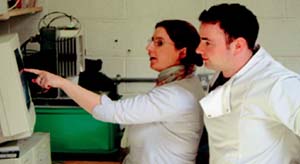| 2004 |

|
YEAR BOOK |
Institute of Technology Carlow
|
Improving TBT bioremediation and analysis
|

The recalcitrant nature of TBT has led to its build up within marine sediments, and has led to a major environmental problem, with millions of tons of sediment needing remediation. Treatment of these contaminated sediments involves deep-sea dumping, land filling or mechanical treatment. Another possible treatment is to use phyto-remediation (plant assisted removal of pollutants from soil).
Phyto-remediation has been shown to be very economical and effective in the removal of organic and heavy metals pollutants from contaminated soils. Plants generally have a very low uptake of TBT, but the Endegrade research group at IT Carlow, together with the NAMBOT (Nano Analytical Micro-Biology Optical Telecommunications) group, are developing a new strategy to improve the phyto-remediation and analysis of TBT contaminated sediments. The Endegrade group hope to improve TBT phyto-remediation by inoculating salt tolerant plants with bacteria that are resistant to or degrade TBT, thereby increasing the uptake by the plant and removal of TBT from the sediment.
Removal of TBT will be assessed using the tensiograph method developed by the NAMBOT group at IT Carlow. The technique examines light reflections inside a forming drop of a liquid. The NAMBOT research team is now involved in an EU-funded project called Aqua-STEW (Water Quality Surveillance Techniques for Early Warning by Tensiographic Sensors). The aim of this project is to implement an on-line monitoring system for water quality monitoring. As part of this project, 19 priority pollutants, such as polyaromatic hydrocarbons (PAHs) and pesticides were analysed, and promising results of the identification of these pollutants from a changing background of water have been obtained using a data mining tool developed in IT Carlow. The Endegrade group have already improved phyto-remediation of Toulene, PAHs and 2,4 dichlorophenoxyacetic acid and, together with the NAMBOT group, are hoping to repeat their success with TBT.
Contact: Kieran Germaine or Anne-Charlotte Bertho, Department of Health & Science, Institute of Technology Carlow;
E-mail: [email protected] ; [email protected] ;
Web: http://www.endegrade.dk (ENDEGRADE group);
Web: http://nambot.itcarlow.ie (NAMBOT group)